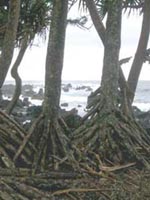Resource Library
Plant of the Week: Screw Pine
The University of Arkansas System Division of Agriculture does not promote, support or recommend plants featured in "Plant of the Week." Please consult your local Extension office for plants suitable for your region.
Plant of the Week
Screw Pine
Latin: Pandanus tectorius

Few of us grow the screw pine (Pandanus tectorius) as a houseplant, yet this Hawaiian tree can be used as a symbol of America’s emergence from an image as an upstart, break-away colony to one destined to have a major impact on world events. The Wilkes Expedition of 1838 to 1842 is a good example of how our forefathers lifted their gaze from the furrow of their own plowed fields to look upon the world about them.
Charles Wilkes (1798-1877), leading a team through a forest of screw pines from Hilo to the top of the active Mauna Loa volcano on the Big Island, described the screw pine as one of the most valuable trees to the native Hawaiians.
It grows at lower elevations on the islands and reaches about 20 feet tall with a number of stout branches bearing long, sword-shaped leaves that spiral around the stem in mostly a clockwise direction. The trunks are bolstered by a number of prominent prop roots that support the stem as it grows.
On female trees a pine-cone looking structure is produced, which helps explain the common name.
Most of the great voyages of exploration were conducted by Europeans during the second half of the 19th century, and by the 1830s most considered the geography of the world fairly well known, with one notable exception. That exception was the far southern Pacific ice field that had driven Captain Cook back in the 1780s. Rumors of an as-yet undiscovered land mass persisted, but it had not been claimed.
Lieutenant Wilkes left the Norfolk Naval Yard with a squadron of six ships and 380 men on what was to be the last voyage of exploration using sails. His mission was to sail south and see if he could find land at the southern end of the world. Secondary missions were of a more utilitarian nature; mapping the islands and atolls of the Pacific and finally exploring the Pacific Northwest and mapping the mouth of the Columbia River and the San Francisco Bay.
Like the European nations, his fleet was staffed by a number of naturalists who were to collect plant, animal, fish, coral and mineral specimens from all areas they visited.
The mountains of Antarctica were sighted in January of 1840. Wilkes’ team beat a French vessel by only three days, but those three days gave him naming rights for the continent.
The expedition was plagued by a number of problems - everything from the loss of ships to attack by cannibals - and many of these trials were made worse by the command style of Wilkes. But, they finally completed the mission and most returned safely to the United States in June of 1842.
The expedition collected almost 10,000 dried plant specimens and a number of living plants. The plants were initially housed in a specially constructed greenhouse behind the Patent Building where they were cared for by William Brackenridge (1810-1893), a Scottish horticulturist who made the voyage.
These plants spurred efforts to establish the U.S. Botanical Garden that was established by Congress soon after the expedition returned.
Perhaps the most lasting legacy of the expedition was that Congress began to directly fund scientific investigations. Before then, Congress was loath to fund projects that did not have some direct, applied economic potential. Science, for science sake, was too frivolous.
The disposition of the dried plant specimens is a good illustration of the state of botanical affairs in the United States in the1840s. A treasure trove of plants was collected from all corners of the globe, but the new nation did not have an herbarium to use to study and compare the plant specimens. The logical solution would have been to ship the material off to Europe and let English, French and German botanists study the specimens in their established herbaria, but that would have been an affront to national pride.
The only botanist capable of doing the research was Harvard’s Asa Gray, who was able to negotiate a princely grant of $120 a month for five years. With the extra funding in place, he was able to complete a volume on the flowering plants in 1854.
The screw pine is an interesting houseplant with dracaena-like characteristics. The most common in the trade is Pandanus veitchii that produces new leaves that have broad white stripes down its light green leaves.
The plants are best in bright locations where they should be grown in large pots; during the winter they should be kept above 60 degrees. If allowed to become too dry, tip burn will result.
By: Gerald Klingaman, retired
Extension Horticulturist - Ornamentals
Extension News - June 11, 2004
The University of Arkansas System Division of Agriculture does not maintain lists of retail outlets where these plants can be purchased. Please check your local nursery or other retail outlets to ask about the availability of these plants for your growing area.